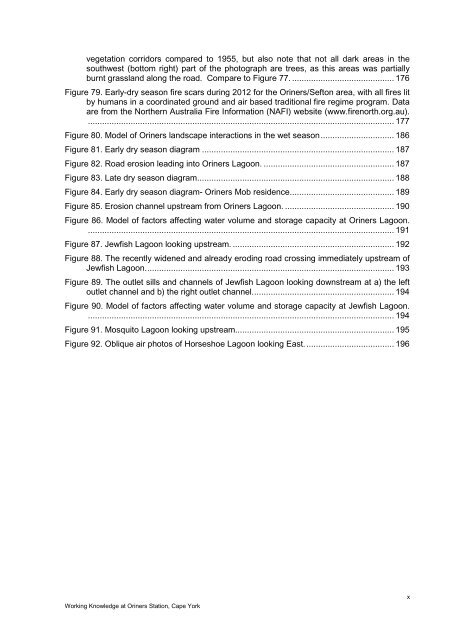WfHC - cover page (not to be used with pre-printed report ... - CSIRO
WfHC - cover page (not to be used with pre-printed report ... - CSIRO
WfHC - cover page (not to be used with pre-printed report ... - CSIRO
You also want an ePaper? Increase the reach of your titles
YUMPU automatically turns print PDFs into web optimized ePapers that Google loves.
vegetation corridors compared <strong>to</strong> 1955, but also <strong>not</strong>e that <strong>not</strong> all dark areas in the<br />
southwest (bot<strong>to</strong>m right) part of the pho<strong>to</strong>graph are trees, as this areas was partially<br />
burnt grassland along the road. Compare <strong>to</strong> Figure 77. ........................................... 176<br />
Figure 79. Early-dry season fire scars during 2012 for the Oriners/Sef<strong>to</strong>n area, <strong>with</strong> all fires lit<br />
by humans in a coordinated ground and air based traditional fire regime program. Data<br />
are from the Northern Australia Fire Information (NAFI) website (www.firenorth.org.au).<br />
................................................................................................................................. 177<br />
Figure 80. Model of Oriners landscape interactions in the wet season ............................... 186<br />
Figure 81. Early dry season diagram ................................................................................. 187<br />
Figure 82. Road erosion leading in<strong>to</strong> Oriners Lagoon. ....................................................... 187<br />
Figure 83. Late dry season diagram ................................................................................... 188<br />
Figure 84. Early dry season diagram- Oriners Mob residence ............................................ 189<br />
Figure 85. Erosion channel upstream from Oriners Lagoon. .............................................. 190<br />
Figure 86. Model of fac<strong>to</strong>rs affecting water volume and s<strong>to</strong>rage capacity at Oriners Lagoon.<br />
................................................................................................................................. 191<br />
Figure 87. Jewfish Lagoon looking upstream. .................................................................... 192<br />
Figure 88. The recently widened and already eroding road crossing immediately upstream of<br />
Jewfish Lagoon. ........................................................................................................ 193<br />
Figure 89. The outlet sills and channels of Jewfish Lagoon looking downstream at a) the left<br />
outlet channel and b) the right outlet channel. ........................................................... 194<br />
Figure 90. Model of fac<strong>to</strong>rs affecting water volume and s<strong>to</strong>rage capacity at Jewfish Lagoon.<br />
................................................................................................................................. 194<br />
Figure 91. Mosqui<strong>to</strong> Lagoon looking upstream................................................................... 195<br />
Figure 92. Oblique air pho<strong>to</strong>s of Horseshoe Lagoon looking East. ..................................... 196<br />
Working Knowledge at Oriners Station, Cape York<br />
x
















